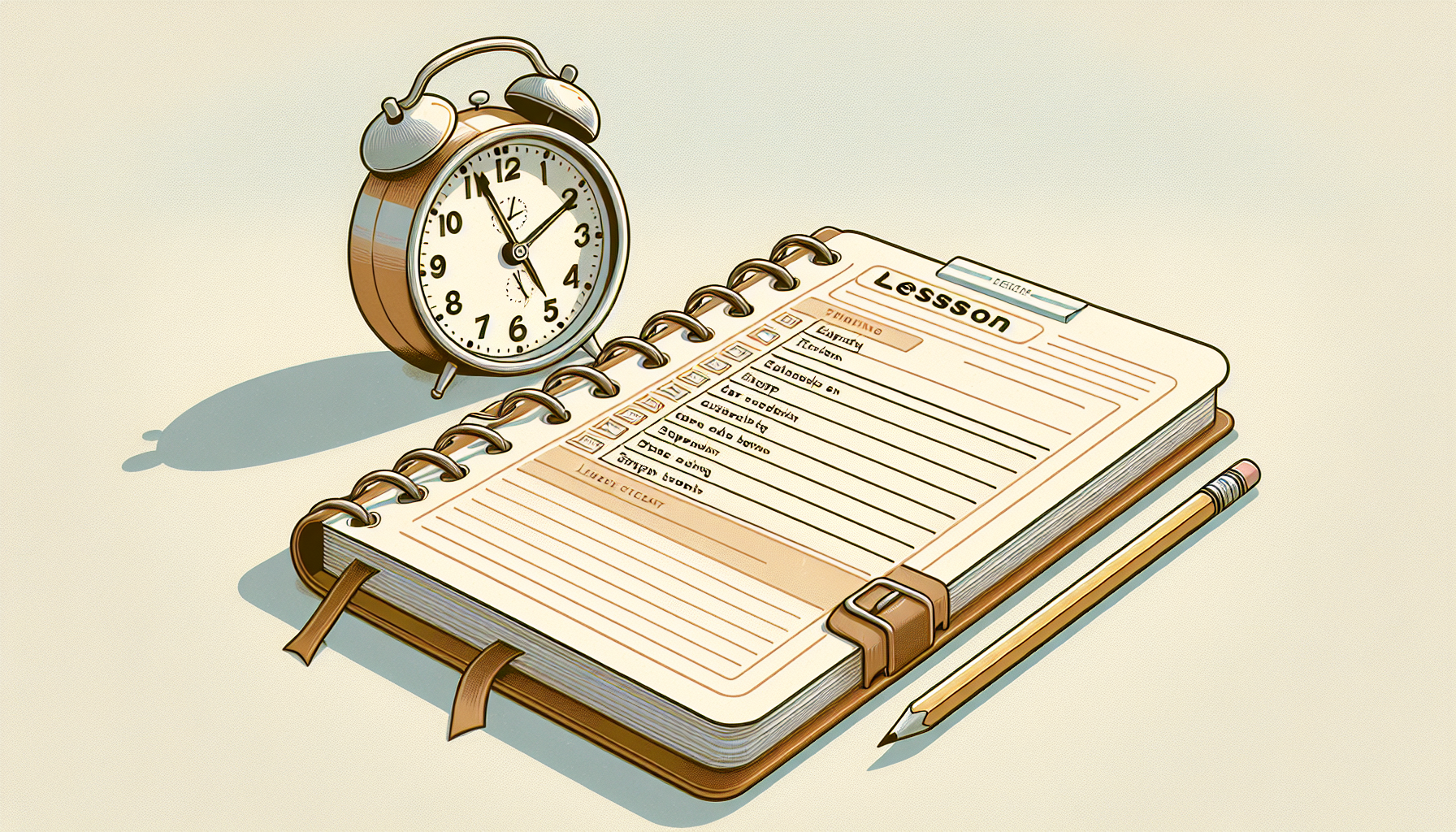Writing a lesson plan can feel like trying to solve a Rubik’s Cube without any instructions, right? For beginners, it might seem overwhelming with all the details and structure involved. You’re not alone in feeling that way!
But don’t worry, if you hang tight with me, I’ll walk you through each step of crafting an effective lesson plan that even a seasoned teacher would be proud of. Imagine having a clear roadmap that makes teaching enjoyable and organized!
We’ll cover everything from understanding the purpose behind lesson plans to finding the perfect materials and structuring your activities. Plus, I’ll throw in some tips and real examples to inspire you along the way!
Key Takeaways
- Lesson plans are essential as they organize teaching, improve classroom management, and enhance student engagement.
- Set clear learning objectives using the SMART criteria to give direction and assess student progress.
- Select appropriate materials that align with your objectives and accommodate different learning styles.
- A good lesson plan has four core components: introduction, main activity, assessment, and conclusion.
- Timing is important; allocate time for each section to keep your lesson on track.
- Keep lesson plans simple and use bullet points for clarity and quick reference.
- Be flexible and ready to adapt your lesson based on student engagement.
- Regularly review and revise your plans using student feedback to improve future lessons.
- Look at examples and additional resources for diverse approaches to lesson planning.

How to Write a Lesson Plan for Beginners
1.1 Understand the Purpose of a Lesson Plan
A lesson plan acts as a roadmap for teachers, detailing the objectives, strategies, and assessment methods for a specific teaching session.
Understanding its purpose is crucial, as this document not only organizes your thoughts but also enhances the learning experience for students.
With a well-crafted lesson plan, teachers can align their lessons with curriculum standards and deliver consistent, effective instruction.
Beyond organization, lesson plans serve as a framework for adapting teaching strategies to meet the diverse needs of students.
Ultimately, they can significantly improve classroom management and engagement by providing a clear structure for both teaching and learning.
1.2 Identify Learning Objectives
Learning objectives are the goals that outline what students will know or be able to do by the end of a lesson.
These should always be specific, measurable, attainable, relevant, and time-bound—which is what the SMART criteria advocate for.
For instance, instead of saying, “Students will understand photosynthesis,” you might say, “Students will be able to describe the process of photosynthesis and explain its importance to plant life.”
This clarity helps you remain focused during your lesson and gives students a clear understanding of their expectations.
Learning objectives also provide a basis for assessing student progress and achievement, which can guide your future lesson planning.
1.3 Choose the Right Materials and Resources
Selecting the appropriate materials and resources is key to making your lesson plan effective.
Think about what tools will best help you achieve your learning objectives; this may include textbooks, online articles, videos, or hands-on materials.
If you’re teaching a science lesson, for example, consider hands-on experiments or interactive simulations that can enrich the learning experience.
It’s also essential to ensure that your resources are aligned with the curriculum and accessible to all students, taking into account different learning styles and abilities.
While professional literature can be invaluable, don’t underestimate the power of student-created materials; their perspective can offer fresh insights into the learning process.
1.4 Structure Your Lesson Plan
A well-structured lesson plan provides clarity and direction for both the teacher and the students.
In essence, all good lesson plans typically comprise four core components: the introduction, main activity, assessment, and conclusion.
Here’s a breakdown of each segment to help you get started:
1.4.1 Introduction
The introduction sets the tone for your lesson and should grab students’ attention right from the start.
Consider using engaging questions or surprising facts to pique their interest.
Additionally, this section is an excellent opportunity to connect the lesson to previous learning, helping students bridge concepts they already know with new material.
A short, relevant story or a compelling visual can also effectively contextualize the lesson.
1.4.2 Main Activity
This is where the bulk of your teaching happens, so make sure to plan engaging, interactive activities that align with your objectives.
Incorporate various teaching methods, such as group discussions, hands-on experiments, or multimedia presentations, to cater to different learning styles.
Make sure to encourage student participation, as this not only fosters deeper learning but also helps maintain interest throughout the lesson.
Be prepared to adjust based on how the students engage with the activity; flexibility is key!
1.4.3 Assessment
Assessment helps you evaluate whether students have met the learning objectives you set.
This can be formal—like a quiz or test—or informal, such as class discussions or observation.
Utilize a mix of formative (ongoing) and summative (at the end) assessments to get a well-rounded view of student understanding.
Providing constructive feedback is crucial at this stage, as it helps students understand what they did well and areas for improvement.
Don’t forget to plan for adjustments to future lessons based on these assessments to continuously adapt your teaching methods.

1.5 Include Timing for Each Section
Timing is crucial in lesson planning, as it ensures that every part of your lesson gets the attention it deserves.
When planning, estimate how long each section should take to keep your lesson on track.
Start by breaking your lesson into the main components: introduction, activity, assessment, and conclusion.
For example, if your entire class is one hour, you might allocate 10 minutes for the introduction, 30 minutes for the main activity, 10 minutes for assessment, and 10 minutes for the conclusion.
It’s wise to build in some buffer time for unexpected questions or discussions.
Also, try timing yourself during practice runs to see if your estimates are realistic.
Adjust as necessary, keeping flexibility in mind to accommodate different pacing for varied student engagement.
1.6 Tips for Clear and Effective Lesson Plans
Writing a lesson plan that’s both clear and effective can make your teaching experience smoother.
Here are some tips to help you craft a plan that is easy to follow:
1.6.1 Keep it Simple
Complex lesson plans can confuse you and your students, so aim for simplicity.
Use straightforward language and avoid educational jargon that may not resonate with everyone.
Having clear, concise goals makes understanding the lesson easier for both the teacher and students.
Consider using a template that incorporates only the essential elements.
This will facilitate quick reference and adjustments on the fly.
1.6.2 Use Bullet Points
Bullet points are a fantastic way to organize your thoughts and make your lesson plan visually friendly.
Instead of long paragraphs, break down information into lists.
Use bullet points for objectives, materials needed, and assessment methods, which makes locating details effortless.
This structure allows quick scanning and reference during class.
A clean layout can also minimize distraction and keep you focused on your teaching.
1.6.3 Be Flexible
Flexibility is key in lesson planning because no two classes are the same.
Be prepared to adapt your lesson based on student responses and engagement levels.
If a discussion runs longer than you expected, adjust other sections instead of cutting off the conversation.
Stay attuned to your students’ needs and feelings, allowing for those teachable moments that come from spontaneous questions or interests.
That adaptability can enhance the learning experience significantly, making your lessons more dynamic and relevant.
1.7 Review and Revise Your Lesson Plan
Reviewing and revising your lesson plans is a vital part of the teaching process.
After every lesson, take a few minutes to reflect on what went well and what didn’t.
Gather feedback from your students; they can often provide insight into their learning experiences.
Consider what adjustments you can make for next time—whether that’s changing the pace, using different materials, or rephrasing your explanations.
Planning is not a one-and-done task; it requires being open to continuous improvement.
Document these reflections to help inform future lesson plans, creating a cycle of growth and development.
1.8 Examples of Lesson Plans for Different Subjects
Seeing examples of lesson plans can really inspire your own planning process.
Depending on the subject, the format and content may differ, but the fundamental structure remains the same.
For instance, a science lesson might focus heavily on hands-on experimentation, while a literature class might emphasize discussion and analysis.
Websites like Teachers Pay Teachers offer a treasure trove of examples across various disciplines.
Procure lesson plans to use as a template and modify to meet your classroom’s unique needs.
By studying multiple examples, you gain a better understanding of how to balance components effectively and engage students.
1.9 Resources for Further Learning about Lesson Plans
Expanding your knowledge on lesson planning can ultimately enhance your teaching abilities.
There are numerous resources available to help you dig deeper into effective lesson planning.
Online platforms like Edutopia provide articles, videos, and discussions about innovative teaching strategies and lesson ideas.
Books such as “The Daily Five” by Gail Boushey and Joan Moser give practical approaches to structuring lesson time.
Professional development workshops—either in-person or virtual—offer opportunities to learn new techniques directly from experienced educators.
Seek out local education groups or online forums for peer support and shared experiences.
Staying informed and connected will enhance both your teaching craft and the learning experience you provide for your students.

1.8 Examples of Lesson Plans for Different Subjects
Looking for inspiration? Checking out examples of lesson plans can really help you structure your own.
Each subject has its nuances, so your plan might change based on what you’re teaching.
For instance, a math lesson may focus on problem-solving with real-world applications, while a history lesson could hinge on discussions and debates.
Want a creative twist? In a language arts class, you could include a peer-review workshop to enhance writing skills.
Websites like Teachers Pay Teachers can provide a variety of templates and examples you can customize.
You will see different structures based on topics, grade levels, and teaching styles, helping you adapt strategies to fit your classroom needs.
By studying various subject lessons, you’ll better grasp how to engage students and deliver the content effectively.
1.9 Resources for Further Learning about Lesson Plans
Ever feel like you want to level up your lesson planning skills? You’re in luck—there are plenty of resources out there!
Online platforms like Edutopia are gold mines for articles on innovative teaching strategies.
Books can also be a fantastic way to get insights; try “Understanding by Design” by Grant Wiggins and Jay McTighe for a framework that emphasizes planning for understanding.
And don’t forget about professional development opportunities—workshops can offer hands-on experience and new ideas directly from educators who’ve been in the trenches.
Connect with local educational groups or even online forums where teachers share their stories and advice.
This can give you fresh perspectives on lesson planning and help you refine your craft, ensuring your students have the best learning experience possible.
FAQs
The purpose of a lesson plan is to outline the objectives, activities, and assessments for a specific lesson, ensuring effective teaching by providing a structured approach to achieving learning goals.
A well-structured lesson plan typically includes an introduction, main activity, assessment, and conclusion, along with appropriate timing for each section to facilitate smooth transitions and student engagement.
To write effective lesson plans, keep them simple, use bullet points for clarity, remain flexible to adapt as needed, and ensure they are aligned with specific learning objectives to maximize student understanding.
You can find examples of lesson plans online through educational websites, teacher resource platforms, and by consulting teaching guides in bookstores or libraries specific to the subject area of interest.
